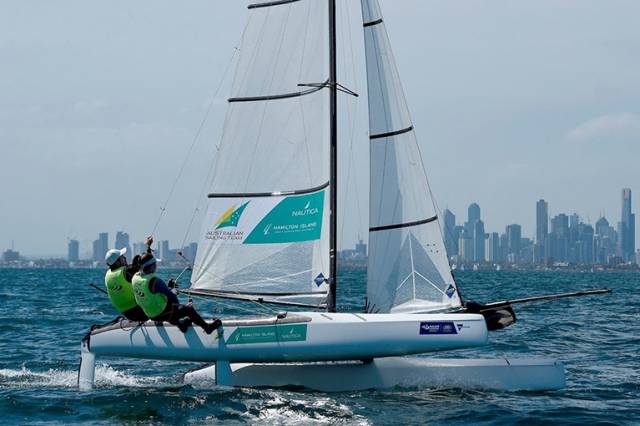Last month the World Sailing Council met in Barcelona, Spain, and confirmed the Nacra 17 will convert to foiling for the Tokyo 2020 Olympic Games, the only foiling class among the 10 Olympic sailing classes. It means Irish sailors with experience in cats or foils – or both – will be busy eyeing up the prospect of a first ever Irish Olympic catamaran campaign.
Most sailors agree the foiling move it’s a natural evolution for the sport and will be a fantastic addition for spectators. The Nacra sailors at Sailing World Cup Final Melbourne say once they’ve mastered the art of foiling it will create thrilling racing.
Not only will the Nacra 17 will be flying in Tokyo but at the same conference in Barcelona the foiling Nacra 15 was confirmed as official equipment for the Youth Olympic Games in Buenos Aires 2018, another prospect for buoyant Irish youth sailors to eye up.
On the announcement, Nacra 17 Rio 2016 silver medallist Lisa Darmanin (AUS) said, “I’m excited and a little scared. While Jase (Jason Waterhouse) is getting technical in Bermuda with the America’s Cup, my plan is to be in the gym becoming bullet proof. When we first start foiling the race course will be pretty scary at times, but come the Games it will be incredible.”
Darmanin’s helm Jason Waterhouse has the advantage of being part of the America’s Cup outfit SoftBank Team Japan who use foiling AC45s. “The foils on the Nacra will be different to the AC but actually learning about campaign management and development has been the biggest eye opener for me, and I’ll bring that experience to our next Olympic campaign.”
Helm John Gimson and crew Anna Burnet (GBR) anticipated the switch and have been sailing a foiling Nacra 20 in Bermuda, plus Gimson spent time on an AC45 during the last Cup cycle.
“We’re really excited about it,” Gimson said while rigging up for day two of their Sailing World Cup Final attempt. “I think it’s going to be quite a full on year getting used to foiling, but I think it’s good for the long term. It’s cool for the sailors to be the only foiling Olympic class and I think it’ll open up a new world for the spectators, and bring the Olympics into the 21st Century.”
“Foiling feels pretty cool, it’s pretty fast, twitchy, and I loved it,” Burnet said of her time on the Nacra 20.
Helm of the only team to take a win off Waterhouse and Darmanin in Melbourne so far and one of the few female Nacra 17 helms worldwide, Kiwi sailor Olivia Mackay, embraces the move to foiling. On the experience of flying above the water she says it’s really quiet and surreal, and hard to judge speed when the boat is lifted on its hydrofoils.
“I’m so excited for the class to go foiling,” Mackay said. “Forty boats foiling into the bottom gates is going to be interesting, and entertaining to watch.”
To retrofit the current generation of Nacra 17s would compromise performance according to Waterhouse, and the plan is for brand new boats to be manufactured. The talk about the yard is the new fleet will be ready in time for next year’s European Championship at Kiel, Germany, in July, but Waterhouse has some reservations that the new technology may price youth and developing nations out of the mixed gender class.
“For a kid it’s going to be harder to convince mum and dad or a federation to fund them in the Nacra, without a result to help them out. The positives are it’s a new challenge and development is part of the sport; it will be good for sailing’s image,” Waterhouse added.
After six of a 12-race schedule in Melbourne, the last event of the six-part World Series, Waterhouse/Darmanin (AUS) lead Mackay/Wilkinson (NZL) by seven points and the Great Britain team sits in third overall.
Not only will the Nacra 17 will be flying in Tokyo but at the same conference in Barcelona the foiling Nacra 15 was confirmed as official equipment for the Youth Olympic Games in Buenos Aires 2018.






























































